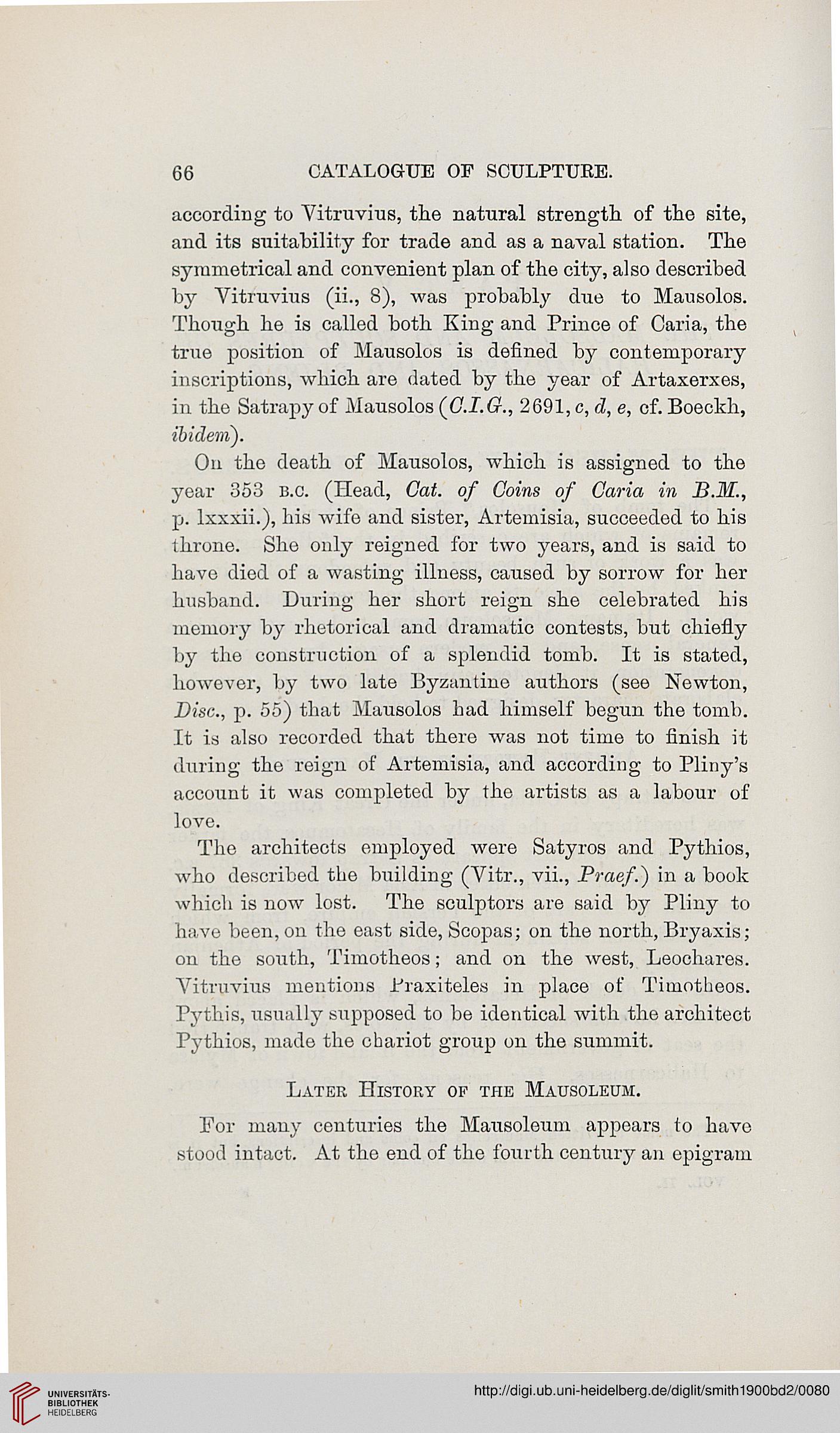66
CATALOGUE OF SCULPTURE.
according to Vitruvius, the natural strength of the site,
and its suitability for trade and as a naval station. The
symmetrical and convenient plan of the city, also described
by Vitruvius (ii., 8), was probably due to Mausolos.
Though he is called both King and Prince of Caria, the
true position of Mausolos is defined by contemporary
inscriptions, which are dated by the year of Artaxerxes,
in the Satrapy of Mausolos (C.I.G., 2691, c, d, e, cf. Boeckh,
ibidem).
On the death of Mausolos, which is assigned to the
year 353 b.c. (Head, Gat. of Coins of Caria in B.W.,
p. lxxxii.), his wife and sister, Artemisia, succeeded to his
throne. She only reigned for two years, and is said to
have died of a wasting illness, caused by sorrow for her
husband. During her short reign she celebrated his
memory by rhetorical and dramatic contests, but chiefly
by the construction of a splendid tomb. It is stated,
however, by two late Byzantine authors (see Newton,
Disc, p. 55) that Mausolos bad himself begun the tomb.
It is also recorded that there was not time to finish it
during the reign of Artemisia, and according to Pliny's
account it was completed by the artists as a labour of
love.
The architects employed were Satyros and Pythios,
who described the building (Vitr., vii., Praef.) in a book
which is now lost. The sculptors are said by Pliny to
have been, on the east side, Scopas; on the north, Bryaxis;
on the south, Timotheos; and on the west, Leochares.
Vitruvius mentions Praxiteles in place of Timotheos.
Pythis, usually supposed to be identical with the architect
Pythios, made the chariot group on the summit.
Later History op the Mausoleum.
For many centuries the Mausoleum appears to have
stood intact. At the end of the fourth century an epigram
CATALOGUE OF SCULPTURE.
according to Vitruvius, the natural strength of the site,
and its suitability for trade and as a naval station. The
symmetrical and convenient plan of the city, also described
by Vitruvius (ii., 8), was probably due to Mausolos.
Though he is called both King and Prince of Caria, the
true position of Mausolos is defined by contemporary
inscriptions, which are dated by the year of Artaxerxes,
in the Satrapy of Mausolos (C.I.G., 2691, c, d, e, cf. Boeckh,
ibidem).
On the death of Mausolos, which is assigned to the
year 353 b.c. (Head, Gat. of Coins of Caria in B.W.,
p. lxxxii.), his wife and sister, Artemisia, succeeded to his
throne. She only reigned for two years, and is said to
have died of a wasting illness, caused by sorrow for her
husband. During her short reign she celebrated his
memory by rhetorical and dramatic contests, but chiefly
by the construction of a splendid tomb. It is stated,
however, by two late Byzantine authors (see Newton,
Disc, p. 55) that Mausolos bad himself begun the tomb.
It is also recorded that there was not time to finish it
during the reign of Artemisia, and according to Pliny's
account it was completed by the artists as a labour of
love.
The architects employed were Satyros and Pythios,
who described the building (Vitr., vii., Praef.) in a book
which is now lost. The sculptors are said by Pliny to
have been, on the east side, Scopas; on the north, Bryaxis;
on the south, Timotheos; and on the west, Leochares.
Vitruvius mentions Praxiteles in place of Timotheos.
Pythis, usually supposed to be identical with the architect
Pythios, made the chariot group on the summit.
Later History op the Mausoleum.
For many centuries the Mausoleum appears to have
stood intact. At the end of the fourth century an epigram




